Go large or go home
Big plastics just might be the right ticket for increasing big-bass hauls
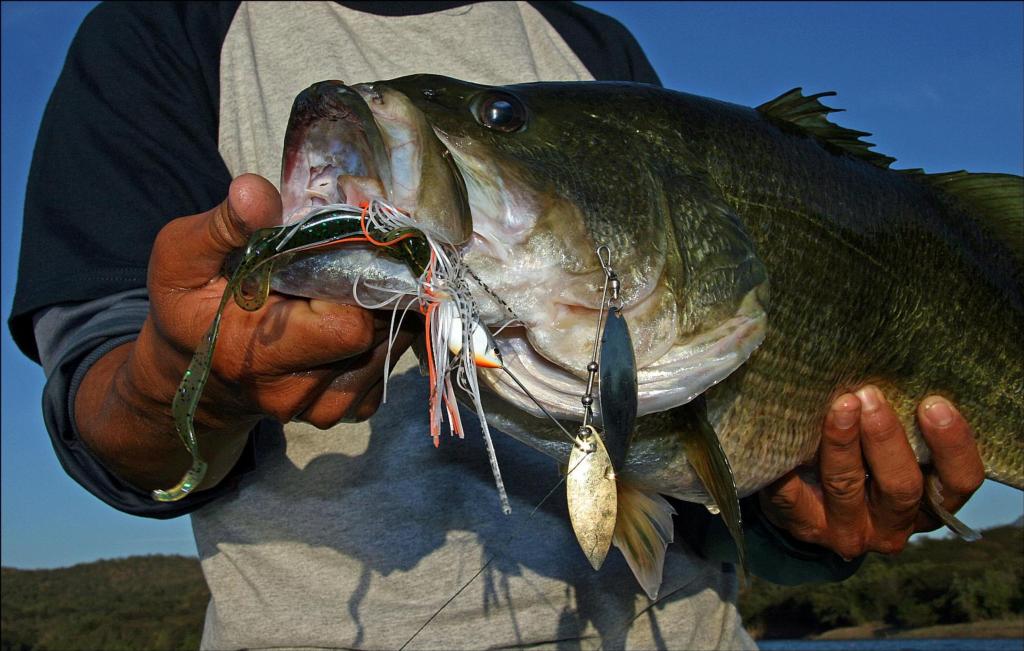
When Ish Monroe missed first place at the Stren Series Western Division event on California’s Lake Oroville by 4 ounces back in May, he probably felt like crawling into a hole – perhaps the very same one where the gopher that mysteriously appeared in his livewell once lived.
No kidding, Monroe found a rodent weighing well more than 4 ounces in his livewell when he sacked up his limit for the final day’s weigh-in. Monroe surmised that the gopher had been displaced by recent rains, gobbled up by a bass and then later regurgitated into Monroe’s livewell. “I think when the water started rising that gopher finally had to leave his hole and when he did, that bass was waiting for him.”
That tells us two things: First, largemouth bass are indiscriminate opportunists. Second, these fish won’t hesitate to grab a meal that will surely test their gullet capacity.
No doubt, throwing the big stuff means aggressive strategy. It’s not an everyday – or everywhere – tactic, but there’s no better way of weeding out the riff raff and finding the ones you want than slinging oversized baits. Smaller fish may take their shot at big targets, and there’s not much you can do about that. However, big fish are far more likely to grab a big bait than a small one.
“I fish big baits pretty much all the time because I’m looking for big fish,” Monroe said. “You can catch big fish on little baits too, but I think the majority of times, a big fish is looking for one big meal.”
Some of it comes down to location. Mexico’s famous bass lakes are known for their lunker potential where on any given day of the week, a first-timer can make that lucky cast and score the fish of a lifetime. Perhaps not quite so predictable, but no less rich in trophy potential are stateside treasures like Falcon Lake and Lake Amistad (Texas) as well as the fabulous California Delta. Visit any of these big fish Meccas and you’re sure to hear of anglers finding large bass floating at the surface with a ridiculously large tilapia, bluegill or trout stuck in their throat.
State fishery departments typically offer historical catch records, as well as lake data and current big fish reports. A little research may help you size up your chances of sticking a toad, but even in waters not known for great numbers of huge bass, some would gladly trade quantity for quality. So stands the eternal question: Do you want to scratch out a limit with bank runners or swing for the fences?
Tube talk
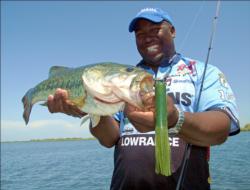 Spend any time around the Cal Delta or Clear Lake and you’ll see a fanatical fixation on big swimbaits. Foot-long trout and bulbous bluegill imitators see a lot of action, particularly around the spawn, but one of Monroe’s favorite weapons is his signature 7-inch Ish tube. Partnering with Picasso, Monroe took his inspiration from California’s saltwater scene in which anglers often drop big tubes for rock cod and lingcod. A random experiment produced a light bulb moment that Monroe had to explore.
Spend any time around the Cal Delta or Clear Lake and you’ll see a fanatical fixation on big swimbaits. Foot-long trout and bulbous bluegill imitators see a lot of action, particularly around the spawn, but one of Monroe’s favorite weapons is his signature 7-inch Ish tube. Partnering with Picasso, Monroe took his inspiration from California’s saltwater scene in which anglers often drop big tubes for rock cod and lingcod. A random experiment produced a light bulb moment that Monroe had to explore.
“I know some saltwater guys who like to go bass fishing, so we trade trips,” he explained. “The bass guys take the saltwater guys fishing for bass and the saltwater guys take the bass guys fishing for rockfish and (other species). One day, a saltwater guy brings his tubes and says `I’m going to try this.’ I kind of laughed at it, but then he pitched it on a bed and I saw (how aggressively) the fish reacted to it and I said, `Huh. I can do that.’
Monroe began bed fishing with big tubes and found that he could consistently tempt big bass as well or better than he could with practically any other bait. It didn’t take long for him to realize that the big-fish appeal probably extended past the sight-fishing game.
“I decided I’ll just try flipping this thing, because if the fish react the way they do on a bed, what about the bed fish you can’t see?” Monroe said. “They pretty much react the same way – they hammer that thing HARD. It’s something big and bulky, so the fish get down there and say `Oh, I gotta eat that!'”
With Monroe’s input, Picasso made whopper tubes with softer consistency for the less toothy freshwater scene and added salt for greater bass appeal. The partnership also yielded the monstrous Picasso 12/0 Ish ProX hook, a serious lip-grabbing hunk of metal sized perfectly for the big tube.
For bed fishing, Monroe pairs his tubes with 1/2-ounce Tru-Tungsten weights. He goes with a 3/8-ounce weight for flipping.
Other “big tube” options include the 7-inch Garland Tora Tube and the Lindy Tiger Tube. Available in 6- and 8-inch models, the later come pre-rigged on jig heads with body hooks and trailer hooks hidden in the tails.
Big baits, big benefits
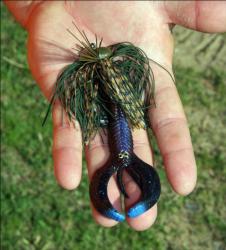 Applications for big plastics also include jigging with large trailers like the 4 ¾-inch Yum Money Craw; flipping hefty water-moving creatures like Reaction Innovations’ Double Wide Beaver; Carolina rigging large lizards like Strike King’s 10-inch 3X Iguana; and Texas rigging titan worms such as the 10-inch Berkley Power Worm, Yum’s 10-inch Big Show Paddle Tail and Gary Yamamoto Custom Baits’ 12-inch Curly Tail worm. (Dressing up a spinnerbait with a large plastic lizard or grub is a real head-turner.)
Applications for big plastics also include jigging with large trailers like the 4 ¾-inch Yum Money Craw; flipping hefty water-moving creatures like Reaction Innovations’ Double Wide Beaver; Carolina rigging large lizards like Strike King’s 10-inch 3X Iguana; and Texas rigging titan worms such as the 10-inch Berkley Power Worm, Yum’s 10-inch Big Show Paddle Tail and Gary Yamamoto Custom Baits’ 12-inch Curly Tail worm. (Dressing up a spinnerbait with a large plastic lizard or grub is a real head-turner.)
With all of these the benefits are many. But in simplest terms, a bigger target yields bigger interest; its simple time and energy management. Bass that live to trophy size have learned the lessons of survival and high on that list is the one about energy gained with each meal vs. energy spent in its acquisition. The promising profile of a big bait convinces a fish that this is prey worth pursuing.
Once you close the sale, big plastics offer more to chew on which in turn stimulates a greater feeding response. From a distance, these baits present more body for fish to see and more water displacement/vibrations for fish to detect in lower visibility. With scented baits, larger bodies release more fish-calling aroma into the water.
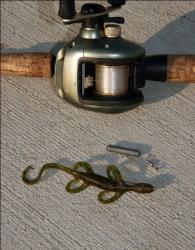 On the strike, a mouthful of plastic also lessens the chance of a fish feeling the hook too soon. With anorexic finesse worms, there’s not much to mask the metal and a hyper-sensitive fish may spit out the rig if they feel the hard stuff before you can jack his jaw.
On the strike, a mouthful of plastic also lessens the chance of a fish feeling the hook too soon. With anorexic finesse worms, there’s not much to mask the metal and a hyper-sensitive fish may spit out the rig if they feel the hard stuff before you can jack his jaw.
From a delivery standpoint, a larger bait means more weight and that means greater casting distance. This is always a good thing, but it’s especially handy on windy days.
Drop(shot) it like it’s hot
Clearly, all this talk of big plastics smacks of brash, in-your-face fishing; but there is a balance to boldness. Say “finesse” to most anglers and they’ll pull out dinky little plastic worms, leeches or minnows maybe 6 inches in length. But not Oregon angler Chris Ricci – he won’t hesitate to run 9- to 10-inch worms on a drop-shot rig.
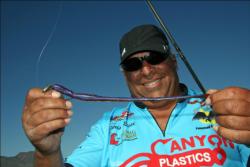 In reality, Ricci takes what is traditionally a finesse rig and employs it for more aggressive flipping and pitching presentations. Preferring ultra-limber hand-poured worms made by Bass Chow and Maverick, Ricci uses 17-pound Berkley 100-percent fluorocarbon line, a 4/0- 5/0 extra wide gap hook and a 3/16-ounce weight on a 4- to 6-inch leader.
In reality, Ricci takes what is traditionally a finesse rig and employs it for more aggressive flipping and pitching presentations. Preferring ultra-limber hand-poured worms made by Bass Chow and Maverick, Ricci uses 17-pound Berkley 100-percent fluorocarbon line, a 4/0- 5/0 extra wide gap hook and a 3/16-ounce weight on a 4- to 6-inch leader.
“The weight of the (large) hook pulls the head of the worm down and the tail floats up so the worm looks like it’s feeding on the bottom,” he said. “When the worm goes down the soft body wiggles and vibrates. The subtleness of the hand poured worm (imparts) all the movement for you.”
With this, or any big plastic presentation, there will be times when a bass will just suck in the bait like he’s sipping a hot cappuccino, while other encounters will feel like the fish is literally trying to break down the bait’s molecular composition. Either way, a big fish is a big fish.
And a big bait just might the strategy of choice for landing your next super-sized catch.